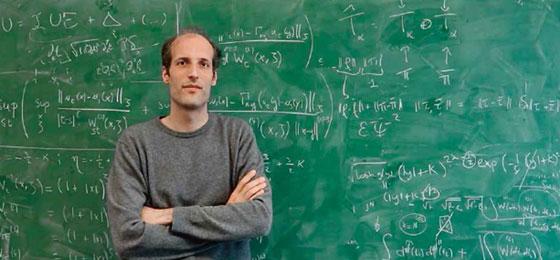The equation tamer

Martin Hairer gives meaning to impossible equations. In 2014, the Regius Professor of Mathematics at the University of Warwick received the highest award in his subject: the Fields Medal. By Daniel Saraga
A sheet of burning paper and a cloth soaking up water appear somewhat mundane events. But for mathematicians, describing these everyday phenomena is an unsolvable riddle.
Or at least it was until last year, when Martin Hairer published a 180-page, key work on a theory of regularity structures. Hairer is a 39-year-old Austrian who grew up and studied in Geneva and who has created a set of new tools that can resolve a large category of recognised problems described by stochastic partial differential equations. These equations describe the changes undergone over time by a multi-dimensional system subject to several non-linear factors, including one that is random. One year since its publication, Hairer’s work has landed him the Fields Medal, often called the Nobel Prize for Maths.
“I read his article the way people read The Lord of the Rings”, says a smiling Lorenzo Zambotti of the Pierre and Marie Curie University, Paris. “The community immediately recognised the implications of his work, even if its members sometimes have difficulty in following all of the technical details”, adds Hendrik Weber of the University of Warwick in the United Kingdom, where Hairer has taught for the last 10 years.
A nearly normal childhood
“I was not a gifted child”, admits Hairer. He became interested in both mathematics and computing at the age of 12. By the time he was 15, he had already won a European competition for young scientists with a computer program for designing electronic circuits. The following year he created a tool for analysing and manipulating music. This program would become Amadeus, a program for Apple computers still used today by sound engineers and DJs.
He went on to study physics at the University of Geneva, where he wrote his thesis under Jean-Pierre Eckmann. Thanks to two SNSF awards, he worked between 2002 and 2004 as a post-doc at the University of Warwick’s renowned mathematics department. He has been there ever since.
The forbidden equation
“In very simple terms, you could say that my work is about finding meaning in poorly defined equations”, explains Hairer. The equations of which he speaks are those written by physicists who wanted to describe problems such as paper burning or magnets losing their magnetism. But in their attempts to resolve them, they had no qualms about breaking them up and approximating them until a solution popped out, the same way an electrician goes about repairing an appliance in a hands-on fashion.
But such an approach is not acceptable for a mathematician. “I want to put things straight and understand what works in the method physicists use. It must be possible to give precise meaning to these equations”, he says. Before looking for a solution, it’s best to ensure that the problem is well defined.
The difficulty lies in the random part of the equation, which describes the unpredictable route taken by the flame as it consumes a sheet of paper. “The edge of the paper is smooth over short distances, but it can become infinitely bumpy on the large-scale. Because of this, we can’t use certain operations needed to write the equation, such as derivatives” (i.e. checking the gradient of the curve, Ed.).
To deal with these impossible problems, Hairer first took the work of Terry Lyons of Oxford University and generalised it to several dimensions, despite it only being applicable to one-dimensional problems. He solved the KPZ equation, a quarter of a century after it was formulated by Mehran Kardar, Giorgio Parisi and Yi-Cheng Zhang (a physicist at the University of Fribourg). He then moved on to tackling a general theory to understand the structures that hide behind stochastic equations.
His idea is to create a solution in a step-by-step, iterative manner, starting with the solution for a simplified equation. But he must first prove that his method produces good solutions. “I figured I could use wavelets – mathematical transformations used in image compression – but I only had a limited understanding of them. At home, I spoke to my wife, who is also a mathematician. She put a book in my hands and said: ‘Read this’! I read half of it that very evening”.
Maths is eternal
His theory of differential stochastic equations may have numerous applications in a range of different areas, but that is not his motivation. “It’s the quest for beauty. Mathematics is the only science that allows for absolute and complete understanding. From the very moment that a specific framework is put in place, something is either true or false”. Another advantage is posterity. “Our understanding of the physical world changes continuously. But a mathematical theorem is true forever”.
According to Zambotti, “he’s not a lone wolf at all. He is very down to earth and always available”. Hairer says he has no fear of ambiguity in his daily life, and spends his spare time cooking and going on walks with his wife. “I can very easily do nothing. I don’t have any problems not thinking about maths for a couple of weeks. After all, even on the quest for beauty and eternity, there has to be time to rest”.
Daniel Saraga is the Chief Editor of the science magazine Technologist.(From "Horizons" no. 103, December 2014)